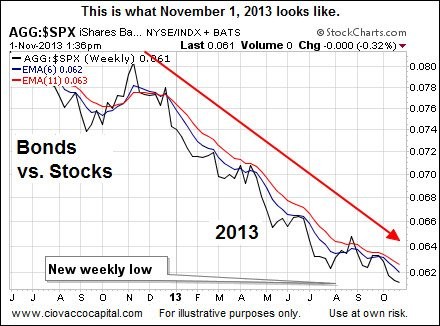How Not to Prepare for a Bear Market in Bonds
Post on: 24 Июль, 2015 No Comment

The risk of rising interest rates has become an obsession in the financial media. Those risks are undeniably real: it’s quite possible that broad-based bond funds will see multiple years with negative returns. (As I illustrated in a previous post. that would likely occur if rates across the yield curve rose 1% annually for three years. This article by Dan Hallett also includes some possible scenarios.) But these risks need to be kept in perspective: if you hold a bond fund with a duration shorter than your time horizon. your capital is not at risk. And if you’re a decade or two from tapping your portfolio, rising rates should even be welcomed .
And yet the bond bears just keep on roaring. The latest example is an advisor featured in a Globe and Mail article this weekend. “For the first time in my entire career,” he says, “bonds are in my opinion riskier than stocks.” He’s recommending his clients abandon the asset class altogether. Whenever articles like this are widely read, I get contacted by worried readers who are ready to follow suit. So here’s my preemptive response to what I believe is dreadful, dangerous advice.
This time isn’t different
To declare bonds are riskier than stocks is just another way of saying “this time it’s different ,” long recognized as the four most dangerous words in investing. It’s also impossible to justify. Even if you’ve been investing for only five years you know stocks can lose 50% of their value in a matter of months. It’s inconceivable that a broad-based bond index fund could suffer a loss of that magnitude unless the Government of Canada defaults on its debt or we experience hyperinflation. A brutal scenario (the yield on 10-year bonds rises steadily from just under 3% to 6% or 7%) would likely see modestly negative returns over three to five years. To suggest investors can reduce their risk by allocating more to stocks and less to bonds is irresponsible.
Yet that’s exactly what the advisor is doing. For investors who currently have a target allocation of 60% stocks and 40% bonds, he’s suggesting a shift to 70% stocks. And what should they use for the other 30% of the portfolio? Market-linked GICs. Really?
If you need a refresher, a market-linked GIC guarantees the investor’s original principal over a specified period, often five years. But instead of paying interest, its returns are tied to the performance of the equity market (either an index or a portfolio of specific stocks). “If we have a rocking bull market, I think the upside is low double digits, and the downside is zero,” the adviser says.
But the downside is not zero. There is a real possibility of getting your principal returned with no return after five years. Meanwhile, you can find conventional five-year GICs paying a risk-free annual return of up to 3%. That’s an opportunity cost that can’t be ignored.
Dividend stocks less risky than bonds?
And what if market-linked GICs aren’t available? In that case the advisor suggests using dividend ETFs in place of bonds. Again, replacing bonds with stocks is presented as risk reduction: “I would respectfully say that in this unique context, I am actually taking risk off the table.” That’s an outrageous statement. Dividend stocks tend to be less volatile than the broad market, but not much. Let’s remember the iShares S&P/TSX Canadian Dividend Aristocrats (CDZ) fell in price more than 46% from September 2008 to March 2009. There is no reason to believe such a decline could not happen again. And there is no “unique context” where dividend stocks could possibly be considered less risky than a broad-based bond index fund, let alone a short-term bond fund or a ladder of GICs.
If you work with an advisor who suggests you should reduce your portfolio’s risk by exchanging bonds for stocks or market-linked GICs, I urge you to push back. If you’ve decided you simply can’t stomach the risk of short-term losses in an asset class that is supposed to be “safe,” that’s fine. But the solutions proposed by this advisor are, in my opinion, entirely inappropriate.
If you fear rising interest rates, the prudent strategy is to reduce the duration of your bond portfolio. That could mean using a short-term bond ETF or a ladder of GICs. both of which would allow you to benefit from an increase in rates. If you’re comfortable with a little credit risk, use short-term investment-grade corporate bonds to get a little more yield. Heck, move your fixed income allocation to cash if you really must. But once you go down the road of “this time it’s different,” you’re taking the first steps on a journey to a dark, unforgiving place.














